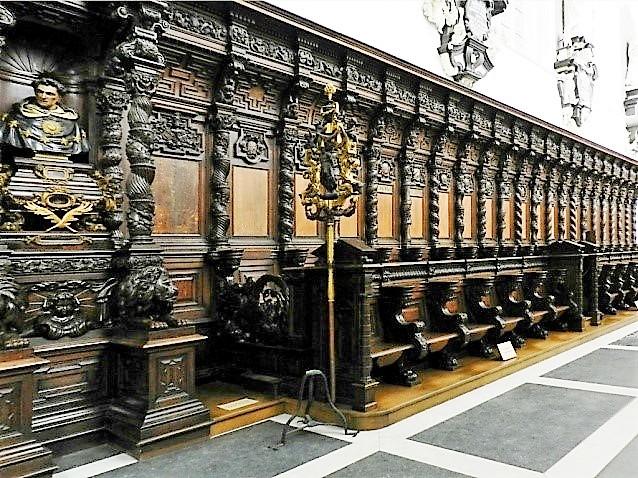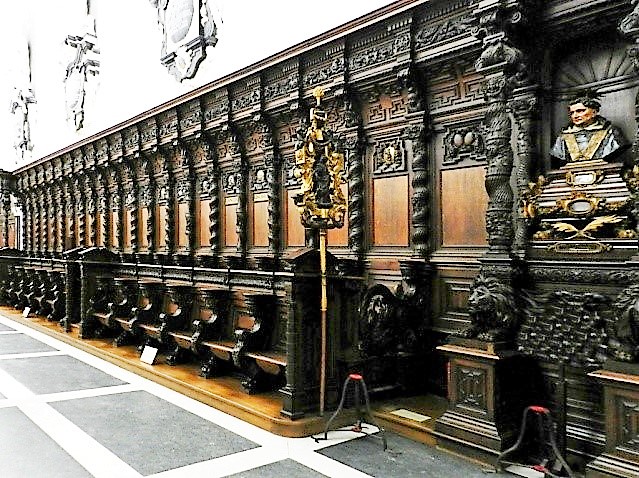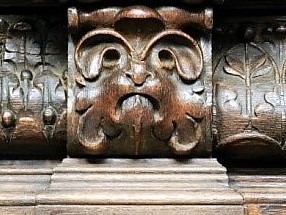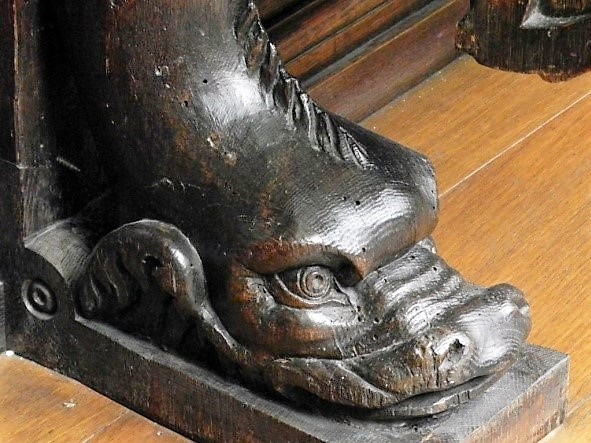Saint Paul’s, the Antwerp Dominican church, a revelation
No convent church without a choir
The choir stallsA series of seats, usually in wood, along the long sides of the choir. These seats are reserved for those who pray and sing the choir prayers.
(Jean de Jupploye?, ca. 1632-1638)
The most important piece of furniture, which was daily used by the Dominicans, are the choirIn a church with a cruciform floor plan, the part of the church that lies on the side of the nave opposite to the transept. The main altar is in the choir. stalls. They provide accommodation for no less than seventy-two religious to praise God.
The ‘choral prayer’ takes place several times a day. For the brothers this ‘divine office’ is a time of personal devotion, whereas for the ordained fathers it is an official task, which they fulfil in the name of the entire church community. This is why it is called ‘office’ (task). The Dominicans normally pray the office four times a day: in the morning (lauds), at noon, in the evening (vespers) and at the closing of the day (compline). At the northern and southern side of the choir the stalls, which were originally positioned in a U, form impressive furniture walls protecting the monks from the cold.
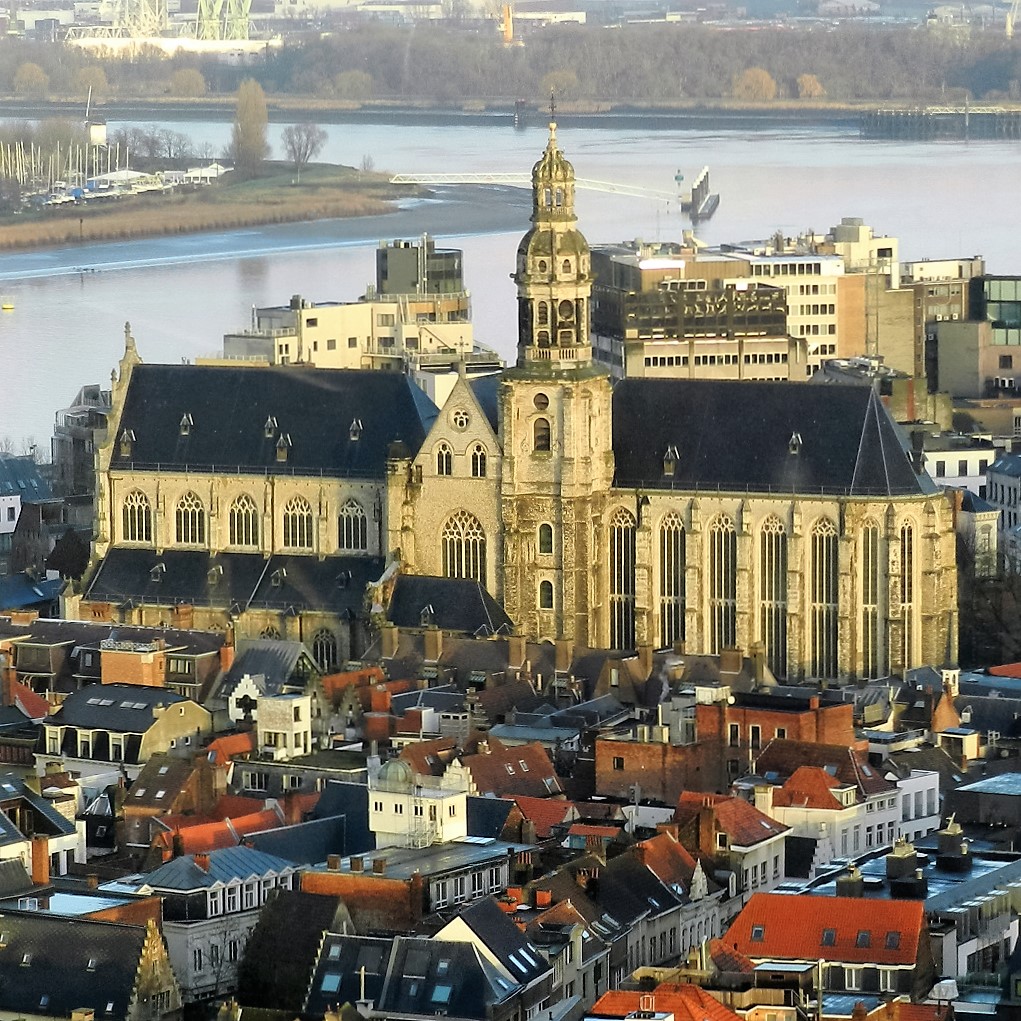
The stalls consist of two rows of which the second is higher than the front one. The lower ones only have seats and standing room, whereas the upper row also has a tall back and carries a heavily worked out cornice. The upper row is considered to be the place of honour and is meant for the older monks; the lower one for the novices.
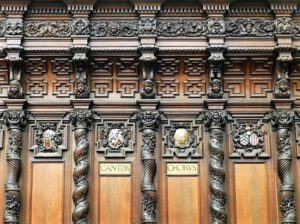 For patrons and sculptors the commission to design 72 modest seats is an opportunity to create an immense piece of church furniture. The structural rectilinearity of the early Baroque choir stalls is kept in balance by a wealth of decorative motifs. By the many profiled elements per partition the perspective line pattern is multiplied, which renders a sublime rhythmic effect to the entire composition. The Baroque foot of the seat has the typical form of a sturdy animal’s paw. In the handle of the seat often a mask has been incorporated. The armrest of the standing place shows a thicker end, below which a three dimensional angel’s head has been hidden. Just as is the case with the angels in the friezes of the panelling the hair dress of the tens of angels is extremely varied. A source of inspiration for exuberant hair styling?
For patrons and sculptors the commission to design 72 modest seats is an opportunity to create an immense piece of church furniture. The structural rectilinearity of the early Baroque choir stalls is kept in balance by a wealth of decorative motifs. By the many profiled elements per partition the perspective line pattern is multiplied, which renders a sublime rhythmic effect to the entire composition. The Baroque foot of the seat has the typical form of a sturdy animal’s paw. In the handle of the seat often a mask has been incorporated. The armrest of the standing place shows a thicker end, below which a three dimensional angel’s head has been hidden. Just as is the case with the angels in the friezes of the panelling the hair dress of the tens of angels is extremely varied. A source of inspiration for exuberant hair styling?
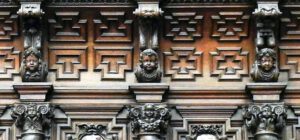 Even though the pilasters have identical structures, they have individual designs. This is most clear in the upward spirals and in the capitals. The vertical drive of the Baroque spiral pilasters is accentuated both by the alternating surfaces of light and shadow, and by the plants growing upwards like ivy. All this is enlivened by playing animals: birds eating berries and fruits, a wild boar and a pig keen on acorns, a monkey and a unicorn.
Even though the pilasters have identical structures, they have individual designs. This is most clear in the upward spirals and in the capitals. The vertical drive of the Baroque spiral pilasters is accentuated both by the alternating surfaces of light and shadow, and by the plants growing upwards like ivy. All this is enlivened by playing animals: birds eating berries and fruits, a wild boar and a pig keen on acorns, a monkey and a unicorn.
The iconography intensified the Dominicans’ praising of God. On the pillars and pilasters flanking the seats the flora joins in singing, while hosts of little angels and animals play music with for example a tambourine, a flute and a violin.
- Saint Paul’s Church
- History and description
- Introduction
- Historic context
- The building history
- Saint Dominic
- Saint Paul
- The tower
- The architecture
- Floor plan and legend
- The sanctuary
- Chapel of the Holy Sacrament
- Our Lady’s chapel
- The mysteries of the Rosary
- Sermon, confession, music
- The mural paintings
- The treasury
- The Calvary garden
- Veemarkt gate
- Dominican pastoral activities
- Dominican convent
- The paintings in the cloisters
- Holy Cross Chapel
- SPK The weekly chapel
- Bibilography
The urge for witticism becomes clear in the many tens of masklike decorations that have been worked into partitions, handles, capitals, friezes and cartouches. There are also innumerable figurative representations. The birds like eating fruit growing on twigs and vines. Often animals quarrel among their own sort, or with snakes and monsters. When looking at the friezes you may find yourself all of a sudden face to face with strange scenes, such as an owl with four young, praying putti, a blessing Christ or God the FatherPriest who is a member of a religious order. in a Roman outfit, an angel playing music and accompanying two singing colleagues.
The coats of arms in the panelled backs belong to persons or authorities that paid for the cost of a seat including the Town of Antwerp and the Margrave of Antwerp.
Part of the choir stalls are a choir lecternA sloping top on a pedestal or as the upper part of a cabinet or table-shaped piece of furniture, on which one can place a book or from behind which one can speak to people. and two precentor stalls. After the old medieval custom the Baroque choir lectern contains an eagle with a bookend on its back. Its orientation towards the sun is symbolic of pious praying man directing himself to God. This also included the Dominicans, who prayed the hours here at least thrice a day. The precentor seats were for the two precentors, to whom both choirs answered alternatingly psalm verse by psalm verse.

After the choir screen had been pulled down in 1833 the two short rows of stalls, with eight seats that had been with their backs against the screen, were sold. They are now to be found in Hotel Adare Manor (Limerick, Ireland). In about 1856 the gap was filled by the so-called lion gates. In 1869 the church wardens wanted to add four extra seats at both sides in the choir stalls. Because the inferior quality of the new pilasters would not be too conspicuous, they were spread over the entire series of choir stalls.
After the new Sint-Paulusstraat had been laid in 1855 and the new entry gate had been built in that street in 1859-1862 a new beautiful entrance in the church itself was created. In 1565 both inner gates to the choir then got too big a frame, which is typically 19th century. The base and the crowning of the woodcarving are by Jean-Baptiste van Rooy and Gerard Van der Linden, as well as the eight carrying lions. For the framing of the four polychrome reliquaryContainer for relics. Often this is a philatory: a decorated glass holder on a pedestal, in which a relic can be placed for veneration. It is important to know that relics cannot be worshipped, only venerated. busts of Dominican saints (beginning 18th century) pillars and pilasters of the Baroque choir stalls were reused.

The central post of the Northern gate shows an image to those who pass by from the sacristyThe room where the priest(s), the prayer leader(s) and the altar server(s) and/or acolyte(s) prepare and change clothes for Mass. at the beginning of the EucharistThis is the ritual that is the kernel of Mass, recalling what Jesus did the day before he died on the cross. On the evening of that day, Jesus celebrated the Jewish Passover with his disciples. After the meal, he took bread, broke it and gave it to his disciples, saying, “Take and eat. This is my body.” Then he took the cup of wine, gave it to his disciples and said, “Drink from this. This is my blood.” Then Jesus said, “Do this in remembrance of me.” During the Eucharist, the priest repeats these words while breaking bread [in the form of a host] and holding up the chalice with wine. Through the connection between the broken bread and the “broken” Jesus on the cross, Jesus becomes tangibly present. At the same time, this event reminds us of the mission of every Christian: to be “broken bread” from which others can live.. An angel with a finger on his mouth summons to be silent, while a second one warns to lift the censor a bit higher so that it would not bump against the steps.
Above the gates the two most important scenes of the patron saint’s life have been worked out in reliefs.
Above the Northern gate: SaintThis is a title that the Church bestows on a deceased person who has lived a particularly righteous and faithful life. In the Roman Catholic and Orthodox Church, saints may be venerated (not worshipped). Several saints are also martyrs. Paul’s conversion. On his way to Damascus Paul was touched by the blinding light Jesus threw to him from Heaven. Because as a Jewish persecutor he received cooperation from the Romans, Paul is represented as a Roman officer. In this way his ‘falling to earth’ got a more dramatic character in tradition by having him fall from a horse. A soldier tries to subdue the bolting horse.

Above the Southern gate: The martyrdom of Saint PaulOriginally, he was called Saul, he was a Jew with Roman citizenship and a persecutor of Christians in the period shortly after the death of Jesus. After his conversion, he became the main gospel spreader in what is now Turkey and Greece. He wrote letters to keep in touch with the Christian communities he had founded, and these texts are the oldest ones in the New Testament. Although he never met Jesus, he is called an “apostle”.. In an execution field Paul kneels down awaiting the headsman’s sword that will also decapitate him. A Roman priestIn the Roman Catholic Church, the priest is an unmarried man ordained as a priest by the bishop, which gives him the right to administer the six other sacraments: baptism, confirmation, confession, Eucharist, marriage, and the anointing of the sick. points at an idol (the emperor’s?) in the background, in a last effort to convince Paul to bow for it. Paul does not pay attention to this and directs his eyes to Heaven. From Heaven an angel sails down to comfort the martyrSomeone who refused to renounce his/her faith and was therefore killed. Many martyrs are also saints. by already offering him the magnificent martyr’s crown. Just like in the original altarThe altar is the central piece of furniture used in the Eucharist. Originally, an altar used to be a sacrificial table. This fits in with the theological view that Jesus sacrificed himself, through his death on the cross, to redeem mankind, as symbolically depicted in the painting “The Adoration of the Lamb” by the Van Eyck brothers. In modern times the altar is often described as “the table of the Lord”. Here the altar refers to the table at which Jesus and his disciples were seated at the institution of the Eucharist during the Last Supper. Just as Jesus and his disciples did then, the priest and the faithful gather around this table with bread and wine. painting by Theodoor Boeyermans, the loyal Plautilla is ready to blindfold Paul at his request.
The majestic level above all this consists of neo-Baroque framings around a canvas: in the North, half length, Saint Dominic, in the South Saint Paul.
The scientific justification of the data concerning the choir of Saint Paul’s in Antwerp can be found HERE.
It is basically written in Dutch, but using the translate button you can ask for an instant translation in English

